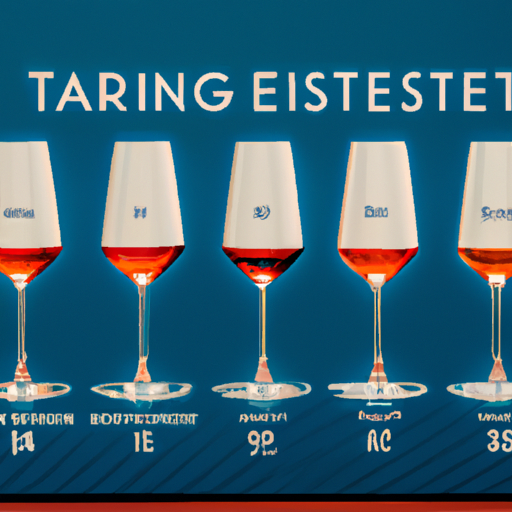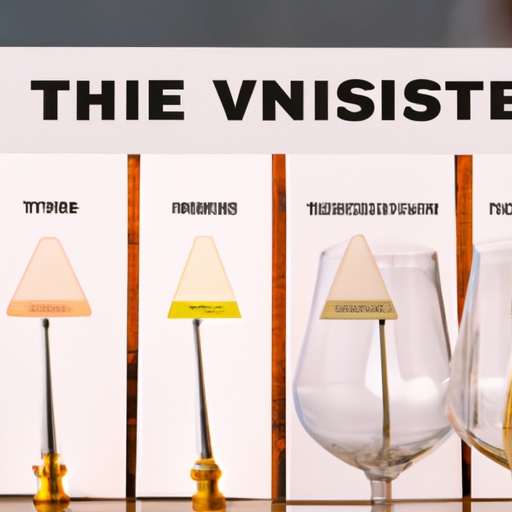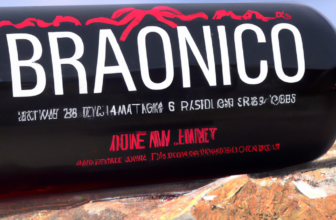
Understanding the Basics: A Guide to 25 Essential Wine Tasting Terms
Understanding the Basics: A Guide to 25 Essential Wine Tasting Terms
Wine tasting can be an intimidating experience for beginners. With a plethora of terms and jargon used by experts, it’s easy to feel overwhelmed. However, by familiarizing yourself with some essential wine tasting terms, you can navigate the world of wine with confidence.
First and foremost, let’s start with the basics. When tasting wine, it’s important to evaluate its appearance, aroma, taste, and finish. These four elements will help you understand and appreciate the wine better.
To begin, the appearance of a wine refers to its color and clarity. Terms such as “pale,” “deep,” “ruby,” and “golden” are commonly used to describe the color of wines. Clarity, on the other hand, refers to how clear or hazy the wine appears in the glass.
Moving on to the aroma, or the smell of the wine, this is where things get interesting. Terms like “fruity,” “floral,” “oaky,” and “earthy” are often used to describe the various scents that can be detected in a wine. A wine’s aroma can give you clues about its grape variety, age, and winemaking techniques.
Next, we come to the taste of the wine. This is where you’ll evaluate its sweetness, acidity, tannin, and body. Terms like “dry,” “sweet,” “crisp,” and “smooth” are commonly used to describe the taste of wines. Sweetness refers to the amount of residual sugar in the wine, while acidity provides a refreshing and tangy sensation. Tannin, on the other hand, is a compound found in red wines that gives them a drying and sometimes bitter taste. Lastly, the body of a wine refers to its weight and texture in the mouth.
Finally, we have the finish, which is the aftertaste that lingers in your mouth after swallowing the wine. Terms like “long,” “short,” “lingering,” and “smooth” are used to describe the finish. A long finish indicates a high-quality wine, while a short finish may suggest a lack of complexity.
Now that we’ve covered the basics, let’s dive into some specific wine tasting terms that you’re likely to encounter:
1. Acidity: The tartness or crispness of a wine.
2. Astringent: A drying sensation in the mouth caused by tannins.
3. Balance: The harmony between a wine’s different components, such as acidity, sweetness, and tannin.
4. Bouquet: The complex aromas that develop in a wine as it ages.
5. Corked: A wine that has been contaminated by a faulty cork, resulting in a musty smell and taste.
6. Decanting: The process of pouring wine from its bottle into a decanter to separate it from any sediment and allow it to breathe.
7. Legs: The droplets that form on the inside of a wine glass after swirling, indicating the wine’s alcohol content and viscosity.
8. Malolactic Fermentation: A secondary fermentation process that converts harsh malic acid into softer lactic acid, resulting in a smoother wine.
9. Nose: Another term for the aroma or bouquet of a wine.
10. Oaky: A wine that has been aged in oak barrels, resulting in flavors and aromas of vanilla, spice, and toast.
11. Residual Sugar: The amount of sugar that remains in a wine after fermentation, contributing to its sweetness.
12. Terroir: The combination of soil, climate, and other environmental factors that influence the character and quality of a wine.
13. Varietal: A wine made primarily from a single grape variety.
14. Vintage: The year in which the grapes used to make a wine were harvested.
15. Wine Legs: The droplets that form on the inside of a wine glass after swirling, indicating the wine’s alcohol content and viscosity.
By familiarizing yourself with these essential wine tasting terms, you’ll be well-equipped to explore the world of wine with confidence. Remember, tasting wine is a subjective experience, so don’t be afraid to trust your own palate and preferences. Cheers to your wine tasting adventures!
Exploring the Language of Wine: 25 Must-Know Wine Tasting Terms

Wine tasting is an art that requires a certain level of knowledge and understanding. To fully appreciate and evaluate a wine, it is important to be familiar with the language of wine. This article will introduce you to 25 essential wine tasting terms that every wine enthusiast should know.
1. Aroma: The smell of a wine, which can range from fruity to floral to earthy.
2. Bouquet: The combination of aromas that develop as a wine ages.
3. Body: The weight and texture of a wine in the mouth, ranging from light to full-bodied.
4. Tannin: A natural compound found in grape skins and seeds that gives a wine its structure and astringency.
5. Acidity: The level of tartness or crispness in a wine, which can range from low to high.
6. Balance: The harmonious combination of acidity, tannin, and fruit in a wine.
7. Finish: The lingering taste and sensation in the mouth after swallowing a wine.
8. Complexity: The layers of flavors and aromas that can be detected in a wine.
9. Terroir: The unique characteristics of a wine that are influenced by the soil, climate, and geography of the vineyard.
10. Vintage: The year in which the grapes were harvested to make a wine.
11. Varietal: A wine made primarily from a single grape variety.
12. Oak: The use of oak barrels in the aging process, which can impart flavors of vanilla, spice, and toast to a wine.
13. Astringent: A drying sensation in the mouth caused by high levels of tannin.
14. Crisp: A wine with high acidity and a refreshing, lively character.
15. Smooth: A wine with a velvety texture and well-integrated flavors.
16. Earthy: A wine with flavors and aromas reminiscent of soil, mushrooms, or truffles.
17. Fruit-forward: A wine that prominently displays its fruity flavors.
18. Mineral: A wine with flavors and aromas reminiscent of stones or minerals.
19. Herbaceous: A wine with flavors and aromas reminiscent of herbs or grass.
20. Spicy: A wine with flavors and aromas reminiscent of spices such as pepper or cinnamon.
21. Sweet: A wine with noticeable residual sugar, giving it a sweet taste.
22. Dry: A wine with little to no residual sugar, resulting in a lack of sweetness.
23. Full-bodied: A wine with a rich, robust character and high alcohol content.
24. Light-bodied: A wine with a delicate, subtle character and low alcohol content.
25. Sparkling: A wine with bubbles, typically achieved through a secondary fermentation process.
These 25 essential wine tasting terms provide a foundation for understanding and discussing wine. By familiarizing yourself with these terms, you will be better equipped to appreciate the nuances and complexities of different wines. So, the next time you find yourself at a wine tasting or enjoying a glass of wine with friends, you can confidently discuss the aromas, flavors, and characteristics of the wine in front of you. Cheers to expanding your wine vocabulary!
Mastering Wine Tasting: Essential Terms Every Wine Enthusiast Should Know
Wine tasting is an art that requires a certain level of knowledge and expertise. To truly appreciate and understand the complexities of wine, it is important to familiarize yourself with the essential terms used in the world of wine tasting. Whether you are a seasoned wine enthusiast or just starting out on your wine journey, these 25 essential wine tasting terms will help you navigate the world of wine with confidence.
1. Aroma: The smell of the wine, which can range from fruity to floral to earthy.
2. Bouquet: The combination of aromas that develop as a wine ages.
3. Body: The weight and texture of the wine in your mouth, ranging from light to full-bodied.
4. Tannin: A natural compound found in grape skins and seeds that gives wine its structure and astringency.
5. Acidity: The level of tartness or crispness in a wine, which adds freshness and balance.
6. Balance: The harmonious combination of acidity, tannin, and fruit in a wine.
7. Finish: The lingering taste and sensation in your mouth after swallowing the wine.
8. Vintage: The year in which the grapes were harvested and the wine was made.
9. Terroir: The unique combination of soil, climate, and geography that gives a wine its distinct character.
10. Varietal: A wine made primarily from a single grape variety.
11. Blend: A wine made from a combination of different grape varieties.
12. Oak: The type of wood used in aging wine, which can impart flavors such as vanilla or spice.
13. Astringent: A drying sensation in your mouth caused by high levels of tannin.
14. Crisp: A wine with high acidity that is refreshing and lively.
15. Smooth: A wine with a velvety texture and well-integrated flavors.
16. Complex: A wine with multiple layers of flavors and aromas that evolve over time.
17. Corked: A wine that has been contaminated by a faulty cork, resulting in a musty or moldy smell.
18. Decanting: The process of pouring wine into a decanter to separate it from any sediment and allow it to breathe.
19. Legs: The droplets that form on the inside of a wine glass after swirling, indicating the wine’s viscosity.
20. Old World: Refers to wines from traditional wine-producing regions in Europe, known for their elegance and restraint.
21. New World: Refers to wines from non-traditional wine-producing regions, often characterized by bold fruit flavors.
22. Sommelier: A trained wine professional who assists with wine selection and service in a restaurant.
23. Corkscrew: A tool used to remove corks from wine bottles.
24. Wine aerator: A device that exposes wine to air, enhancing its flavors and aromas.
25. Wine cellar: A storage space specifically designed to keep wine at the optimal temperature and humidity for aging.
By familiarizing yourself with these essential wine tasting terms, you will be able to confidently discuss and appreciate wine like a true connoisseur. Whether you are attending a wine tasting event, selecting a bottle at a restaurant, or simply enjoying a glass at home, these terms will enhance your understanding and enjoyment of the world of wine. So raise your glass and toast to expanding your wine knowledge with these essential terms!






